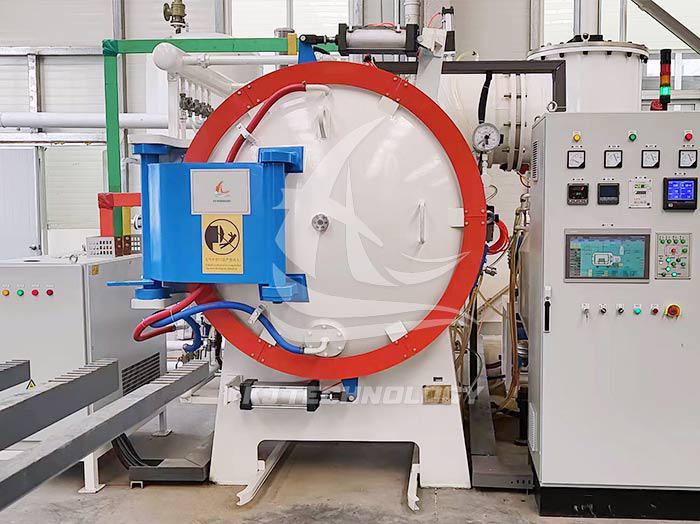Troubleshooting of High Vacuum Heat Treatment Electric Furnace
 09-26-2025 Author: KJ technology
09-26-2025 Author: KJ technology
The troubleshooting of high vacuum heat treatment electric furnaces needs to start from three aspects: electrical faults, vacuum system faults, and mechanical structure faults, and systematically investigate and repair them based on specific phenomena. The following is a detailed troubleshooting guide:
1. Electrical troubleshooting
a. Abnormal temperature
Phenomenon: High temperature alarm or display temperature not reaching the set value.
Exclusion steps:
Temperature controller parameter check: Refer to the temperature controller parameters of other normal devices to verify if the current device parameters are abnormal.
Solid state relay detection:
After power failure, use a multimeter to measure the resistance between two points at the output terminal of the solid-state relay. Normally, the resistance should be several megohms or more. If it approaches zero, it indicates that the relay has broken down and needs to be replaced with a relay of the same model.
Thermocouple inspection:
Gently shake the thermocouple probe while powered on and observe whether the temperature controller displays significant fluctuations. If the jumping is obvious, it indicates poor contact of the probe and needs to be replaced.
Swap the suspected damaged thermocouple with the thermocouple of the normal equipment and observe whether the temperature display returns to normal. If it returns to normal, the original thermocouple is damaged and needs to be replaced (resealing is required when replacing the internal thermocouple).
Heating tube power on test:
After heating with electricity, use a test pen to test the connecting wire of the heating tube (white high-temperature wire at the output end of the solid-state relay) to confirm if there is electricity.
If there is electricity but the temperature is still insufficient, use a clamp meter to measure the current and compare it with the difference in current in other working areas. If the difference is too large, it may cause damage to the heating tube or circuit failure, and further investigation is needed.
If there is no power supply, check the circuit one by one according to the circuit diagram to confirm if any components are burnt out or broken.
b. Controller malfunction
Phenomenon: The controller has no output signal, displays abnormally, or cannot control heating.
Exclusion steps:
Check the internal switches, fuses, and fuses of the controller, and replace damaged components.
Repair the solid-state relay and replace the damaged parts.
Calibrate the temperature controller to ensure it matches the thermocouple scale.
2. Troubleshooting of Vacuum System
a. Insufficient vacuum degree
Phenomenon: The vacuum pump is running but the vacuum degree cannot reach the set value.
Exclusion steps:
Vacuum source inspection: Confirm the vacuum gas source in the factory building.
Vacuum gauge calibration: Compare the vacuum gauge of normal equipment to confirm whether the current gauge is accurate.
Sealing inspection:
Check if the furnace door is tightly closed, if the sealing strip is damaged or deformed, and if there are any foreign objects on the door panel.
Check for leaks at thermocouple entry points, pipelines, and pneumatic valves. If the thermocouple has been replaced, it needs to be re sealed with AB glue.
Vacuum pump maintenance: Clean the oil stains on the vacuum pump, check if the pump body is worn, and replace the vacuum pump if necessary.
b. Vacuum pump malfunction
Phenomenon: The vacuum pump cannot start or operates abnormally.
Exclusion steps:
Check the power circuit and fuse to ensure normal power supply.
Check the oil level and quality of the vacuum pump, and replenish or replace qualified vacuum pump oil.
Repair the vacuum pump coupling and replace worn or broken couplings.
Check the O-ring of the suction valve, re stretch and insert the detached O-ring.
3. Mechanical structure troubleshooting
a. The furnace door cannot be tightly closed
Phenomenon: There is still a gap after the furnace door is closed, resulting in vacuum leakage.
Exclusion steps:
Check if the door hinge is loose, if the buckle is deformed, adjust or replace damaged parts.
Check if the sealing strip at the door is damaged or deformed, and replace it with a qualified sealing strip.
Check if the door panel is deformed, correct or replace the door panel.
b. Abnormal noise from the fan
Phenomenon: The fan produces abnormal noise during operation.
Exclusion steps:
After stopping the machine, check if there are any foreign objects inside the fan impeller and clean them up.
Check if the screws fixing the motor are loose and tighten them.
c. Pneumatic valve cannot operate
Phenomenon: The pneumatic valve does not respond to the control signal.
Exclusion steps:
Check if the solenoid valve is working properly and replace the faulty solenoid valve.
Check if the compressed air pressure meets the working requirements and adjust the air pressure to the normal range.
If the solenoid valve and air pressure are normal, replace the pneumatic valve.








